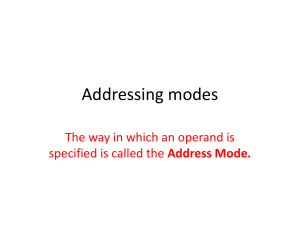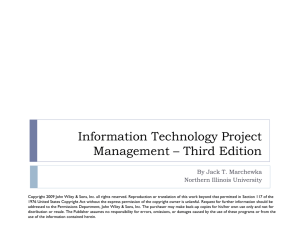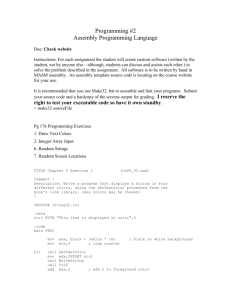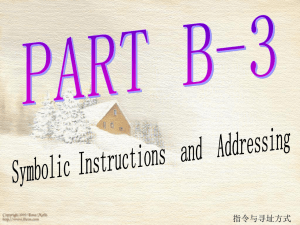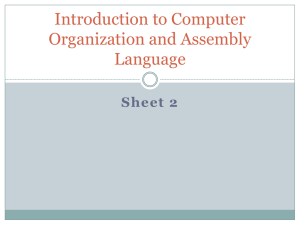- Faculty of Computing
advertisement
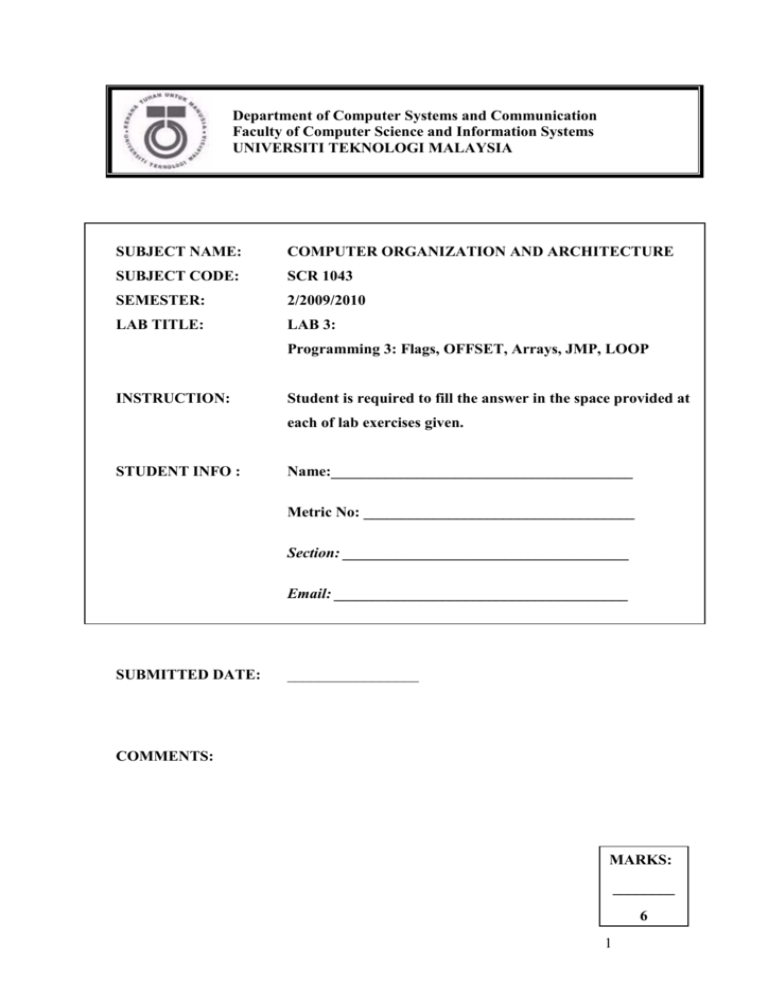
Department of Computer Systems and Communication Faculty of Computer Science and Information Systems UNIVERSITI TEKNOLOGI MALAYSIA SUBJECT NAME: COMPUTER ORGANIZATION AND ARCHITECTURE SUBJECT CODE: SCR 1043 SEMESTER: 2/2009/2010 LAB TITLE: LAB 3: Programming 3: Flags, OFFSET, Arrays, JMP, LOOP INSTRUCTION: Student is required to fill the answer in the space provided at each of lab exercises given. STUDENT INFO : Name:_______________________________________ Metric No: ___________________________________ Section: _____________________________________ Email: ______________________________________ SUBMITTED DATE: _________________ COMMENTS: MARKS: ________ 6 1 Programming 3: Flags, OFFSET, Arrays, JMP, LOOP Flags Affected by Arithmetic The ALU has a number of status flags that reflect the outcome of arithmetic (and bitwise) operations o based on the contents of the destination operand Essential flags: o Zero flag – set when destination equals zero o Sign flag – set when destination is negative o Carry flag – set when unsigned value is out of range o Overflow flag – set when signed value is out of range The MOV instruction never affects the flags. Zero Flag (ZF) The Zero flag is set when the result of an operation produces zero in the destination operand. o mov cx,1 o sub cx,1 ; CX = 0, ZF = 1 o mov ax,0FFFFh o inc ax ; AX = 0, ZF = 1 o inc ax ; AX = 1, ZF = 0 Sign Flag (SF) The Sign flag is set when the destination operand is negative. The flag is clear when the destination is positive. o mov cx,0 o sub cx,1 ; CX = -1, SF = 1 o add cx,2 ; CX = 1, SF = 0 The sign flag is a copy of the destination's highest bit: o mov al,0 o sub al,1 ; AL = 11111111b, SF = 1 o add al,2 ; AL = 00000001b, SF = 0 Overflow and Carry Flags: A Hardware Viewpoint How the ADD instruction modifies OF and CF: o OF = (carry out of the MSB) XOR (carry into the MSB) o CF = (carry out of the MSB) How the SUB instruction modifies OF and CF: o NEG the source and ADD it to the destination o OF = (carry out of the MSB) XOR (carry into the MSB) o CF = INVERT (carry out of the MSB) MSB = Most Significant Bit (high-order bit) XOR = eXclusive-OR operation NEG = Negate (same as SUB 0,operand) 2 Carry Flag (CF) The Carry flag is set when the result of an operation generates an unsigned value that is out of range (too big or too small for the destination operand). o mov al,0FFh o add al,1 ; CF = 1, AL = 00 o ; Try to go below zero: o mov al,0 o sub al,1 ; CF = 1, AL = FF Overflow Flag (OF) The Overflow flag is set when the signed result of an operation is invalid or out of range. o ; Example 1 o mov al,+127 o add al,1 ; OF = 1, AL = ?? o o ; Example 2 o mov al,7Fh ; OF = 1, AL = 80h o add al,1 The two examples are identical at the binary level because 7Fh equals +127. To determine the value of the destination operand, it is often easier to calculate in hexadecimal. OFFSET Operator OFFSET returns the distance in bytes, of a label from the beginning of its enclosing segment o Protected mode: 32 bits o Real mode: 16 bits offset Data segment: myByte Example: o Let's assume that the data segment begins at 00404000h: 3 .data bVal BYTE ? wVal WORD ? dVal DWORD ? dVal2 DWORD ? .code mov esi,OFFSET mov esi,OFFSET mov esi,OFFSET mov esi,OFFSET bVal wVal dVal dVal2 ; ; ; ; ESI ESI ESI ESI = = = = 00404000 00404001 00404003 00404007 Arrays How to handle an array? Use register as a pointer, the method is called indirect addressing. Array Sum Example: o Indirect operands are ideal for traversing an array. Note that the register in brackets must be incremented by a value that matches the array type. .data arrayW WORD 1000h,2000h,3000h .code mov esi,OFFSET arrayW mov ax,[esi] add esi,2 ; or: add esi,TYPE arrayW add ax,[esi] add esi,2 add ax,[esi] ; AX = sum of the array JMP (Jump) Causes unconditional transfer to a destination (label) that is usually within the same procedure. Format: JMP destination Logic: EIP target Examples: o top: . . . jmp top ; repeat the endless loop 4 LOOP repeats a block of statements a specific number of times. ECX is automatically used as a counter and is decremented each time the loops repeats. Format: LOOP destination Logic: o ECX ECX – 1 o if ECX != 0, jump to destination Implementation: o The assembler calculates the distance, in bytes, between the offset of the following instruction and the offset of the target label. It is called the relative offset. o The relative offset is added to EIP. The following loop calculates the sum of the integers 5 + 4 + 3 +2 + 1: offset 00000000 00000004 machine code 66 B8 0000 B9 00000005 00000009 0000000C 0000000E 66 03 C1 E2 FB source code mov ax,0 mov ecx,5 L1: add ax,cx loop L1 When LOOP is assembled, the current location = 0000000E (offset of the next instruction). –5 (FBh) is added to the current location, causing a jump to location 00000009: 00000009 0000000E + FB Exercises Lab: 1. For each of the following marked entries, show the values of the destination operand and the Sign, Zero, and Carry flags: mov ax,00FFh add ax,1 ; AX= _____________________ SF= ___ ZF= ___ CF= ___ sub ax,1 ; AX= _____________________ SF= ___ ZF= ___ CF= ___ add al,1 ; AL= _____________________ SF= ___ ZF= ___ CF= ___ mov bh,6Ch add bh,95h ; BH= _____________________ SF= ___ ZF= ___ CF= ___ mov al,2 sub al,3 ; AL= _____________________ SF= ___ ZF= ___ CF= ___ 5 2. What will be the values of the Overflow flag? mov al,80h add al,92h ; AL= _____________________ OF = _____ mov al,-2 add al,+127 ; AL= _____________________ OF = _____ 3. What will be the values of the given flags after each operation? mov al,-128 neg al ; AL= ___________________ CF = ____ OF =____ mov ax,8000h add ax,2 ; AX= ___________________ CF = ____ OF =____ mov ax,0 sub ax,2 ; AX= ___________________ CF = ____ OF =____ mov al,-5 sub al,+125 ; AL= ___________________ CF = ____ OF =____ 4. What will be the final value of AX? mov ax,20 mov ecx,4 L1: inc ax neg ax loop L1 In each Loop: Loop 1: AX= ___________________ Loop 2: AX= ___________________ Loop 3: AX= ___________________ Loop 4: AX= ___________________ 6 5. The following code calculates the sum of an array of 16-bit integers. .data intArray WORD 100h,200h,300h,400h .code mov edi,OFFSET intArray ; address of intArray EDI= ______________ mov ecx,LENGTHOF intArray mov ax,0 ; loop counter ECX= ______________ ; zero the accumulator L1: add ax,[edi] ; add an integer add edi,TYPE intArray loop L1 ; point to next integer ; repeat until ECX = 0 AX= _____________________, Number of Loop: = ______________ What changes would you make to the program if you were summing a doubleword array? .data intArray ___________ 100h,200h,300h,400h .code mov edi,OFFSET intArray ; address of intArray EDI= ______________ mov ecx,LENGTHOF intArray mov _______, 0 ; loop counter ECX= ______________ ; zero the accumulator (use accumulator AX) L1: add _______,[edi] ; add an integer add edi,TYPE intArray loop L1 ; point to next integer ; repeat until ECX = 0 EAX= _____________________, Number of Loop: = _____________ 7



